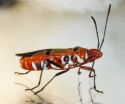(Press-News.org) Singapore, 9 January 2013
Attitudes of Singaporeans and permanent residents toward gays and lesbians although sharply polarised and predominantly negative, have shifted slightly over a five-year span to become a little more favourable. This was found by a research team from the Wee Kim Wee School of Communication and Information at Nanyang Technological University (NTU).
A nationally representative survey found that people with higher levels of education and freethinkers tend to have more positive attitudes. Those who had higher interpersonal contact with gay men and lesbians and watched more films and television shows with homosexual characters were also likely to express more positive attitudes toward gays and lesbians, and to show greater acceptance.
"This study is a continuation of an earlier one in 2005, which was initiated to provide a nationally representative and objective examination of public attitudes toward homosexuality in Singapore and to contribute to scholarship on homosexuality in Asia. By investigating some of the predictors of attitudes towards lesbians and gay men, it can help to inform public debate and guide future policy recommendations," said Professor Benjamin Detenber, Chair of the Wee Kim Wee School of Communication and Information, who led a team of researchers to conduct this study in early 2010.
The study of 959 adult Singaporeans and permanent residents (PRs) found that while there has been a slight change in attitudes towards lesbians and gays in Singapore between 2005 and 2010, the change is significant, as it suggests a temporal shift in Singaporeans' values and views about homosexuals.
The study was published in the Asian Journal of Social Psychology at the end of last month, and it is a follow-up to an earlier one, which sampled 1,004 adult Singapore citizens and PRs in January 2005. These studies aim to provide empirically grounded research in gauging and tracking attitudinal changes toward gay men and lesbians in Singapore society over time.
When results from both surveys in 2005 and 2010 were compared, Singaporeans' attitudes towards homosexuals appear to have shifted more positively. "Taken together, the results show a small but significant trend toward greater tolerance of homosexuals," said Prof Detenber.
In 2005, 68.6 percent of respondents expressed negative attitudes, 22.9 percent had positive attitudes and 8.5 percent were neutral. In 2010, 64.5 percent of those surveyed held negative attitudes towards homosexuals, while 25.3 percent expressed positive attitudes and 10.2 percent were neutral.
"Clearly, public opinion is still highly polarised on this issue, but slightly more people are sharing the middle ground in 2010 compared to 2005," Prof Detenber said. The study found that older people tend to have more negative attitudes towards lesbians and gays, as do those with lower levels of education and income. On the other hand, people who feel it is less important to conform to social norms and those with a more Western cultural orientation tend to have less negative attitudes and be more accepting of homosexuals.
Similar to studies conducted elsewhere, the survey found that Singapore citizens and PRs who have a gay or lesbian family member or know someone who is homosexual are less likely to have negative attitudes and be more accepting.
Interpersonal contact also appears to have a bigger influence in shaping attitudes and acceptance of homosexuals than mediated exposure to homosexual characters – i.e. seeing gays and lesbians in films and television programmes – which also predicted less negative attitudes and greater acceptance.
Previous studies showed that exposure to gay characters in the media has the most effect on the attitudes of people with little or no interpersonal contact with gay men and lesbians. In contrast, the 2010 study found that viewing gays and lesbians in the media has the strongest effect on the attitudes of people with many personal contacts with gay men and lesbians.
The researchers suggested this could be because of the positive correlation between interpersonal contact and media exposure to homosexuals in this sample of Singaporean adults. Alternatively, it could be due to the way in which exposure to homosexuals in the media has been measured. The 2010 study used the total number of films and TV programmes watched, whereas other studies used viewing frequency and scale measurements of para-social relationships between viewers and media characters.
The study also showed that it is possible for people to hold negative attitudes towards homosexuals but accept gay men and lesbians on a more personal level, whether as co-workers or friends, regardless of whether they perceive homosexuality to be a choice. The researchers suggested that the precise reasons for this could be the subject of future research.
"As more Singaporeans come into contact with gay people and with the rising availability of films and television programmes with gay characters via cable television, local cinemas and the Internet, it seems possible that there will be a more significant shift in attitudes towards gays and lesbians over time," said co-investigator, Dr Shirley Ho.
As was the case in 2005, the more recent study found that religion is significantly related to attitudes and acceptance. Among the religious groups, freethinkers were the most positive in their attitudes – significantly higher than Christians, Buddhists and Muslims. Irrespective of specific religion, people who are more intrinsically religious – i.e. people who say that religion is integral to their lives – are more likely to have negative attitudes towards homosexuals and are less accepting of them.
Prof Detenber said, "It is important to bear in mind that the findings are correlational and probabilistic – that is, the results refer to trends in associations among variables (e.g. demographics, value predispositions, attitudes, etc), and do not identify causal relationships. While some of these associations are rather modest, they are statistically significant and meaningful."
The team is planning to conduct a similar survey in 2015 to better understand public opinion of homosexuality and to track changes over time.
###
Media contact:
Feisal Abdul Rahman
Senior Assistant Director (Media Relations)
Corporate Communications Office
Nanyang Technological University
Tel: (65) 6790 6687
Email: feisalar@ntu.edu.sg
About Nanyang Technological University
A research-intensive public university, Nanyang Technological University (NTU) has 33,500 undergraduate and postgraduate students in the colleges of Engineering, Business, Science, and Humanities, Arts, & Social Sciences. In 2013, NTU will enrol the first batch of students at its new medical school, the Lee Kong Chian School of Medicine, which is set up jointly with Imperial College London.
NTU is also home to four world-class autonomous institutes – the National Institute of Education, S Rajaratnam School of International Studies, Earth Observatory of Singapore, and Singapore Centre on Environmental Life Sciences Engineering – and various leading research centres such as the Nanyang Environment & Water Research Institute (NEWRI), Energy Research Institute @ NTU (ERI@N) and the Institute on Asian Consumer Insight (ACI).
A fast-growing university with an international outlook, NTU is putting its global stamp on Five Peaks of Excellence: Sustainable Earth, Future Healthcare, New Media, New Silk Road, and Innovation Asia.
Besides the main Yunnan Garden campus, NTU also has a satellite campus in Singapore's science and tech hub, one-north, and is setting up a third campus in Novena, Singapore's medical district.
For more information, visit www.ntu.edu.sg
NTU study looks at national attitudes towards homosexuals
Study compares results from earlier survey carried out 5 years ago
2013-01-09
ELSE PRESS RELEASES FROM THIS DATE:
How the brain stays receptive
2013-01-09
The channel protein Pannexin1 keeps nerve cells flexible and thus the brain receptive for new knowledge. Together with colleagues from Canada and the U.S., researchers at the Ruhr-Universität Bochum led by the junior professor Dr. Nora Prochnow from the Department of Molecular Brain Research describe these results in PLoS ONE. In the study, mice comprising no Pannexin1 in memory-related brain structures displayed symptoms similar to autism. Their nerve cells lacked synaptic plasticity, i.e. the ability to form new synaptic contacts or give up old contacts based on the level ...
Researchers reveal most effective treatment for common kidney disorder
2013-01-09
The results of a pioneering UK-wide clinical trial that compared treatments for patients with a common type of kidney disease has found one to be significantly more effective. The results of the study, published online in The Lancet today [9 Jan], will be recommended to clinicians worldwide as the most effective approach to treating the condition.
The Medical Research Council-funded study, led by researchers from the University of Bristol's Academic Renal Unit based in Southmead Hospital, compared three treatment approaches in a type of kidney disorder known as 'membranous ...
New study identifies significance of co-infection in disease control
2013-01-09
The new study analyses data from school aged children in Tanzania infected with the most common forms of worms. It was found that infection by one parasitic species actually changes the risk of catching another, over and above other risk factors.
The study is the first to look at the significance of infection with one disease as a risk for further infections (i.e. co-infection). The findings could help us better understand the importance of co-infection as a risk, and could help inform disease control strategies.
Traditionally, co-infection, where the person or ...
The Teotihuacans exhumed their dead and dignified them with make-up
2013-01-09
In collaboration with the National University of Mexico, a team of Spanish researchers has analysed for the first time remains of cosmetics in the graves of prehispanic civilisations on the American continent. In the case of the Teotihuacans, these cosmetics were used as part of the after-death ritual to honour their city's most important people.
A research team from the Polytechnic University of Valencia and the University of Valencia has studied various funerary samples found in urns in the Teotihuacan archaeological site (Mexico) that date from between 200 and 500 ...
R U eating healthy 2day?
2013-01-09
AUDIO:
Melanie Hingle, Ph.D., MPH, RD, University of Arizona, discusses the effectiveness of using text messaging to engage adolescents in ‘‘conversations’’ about health using a familiar communication method -- that is...
Click here for more information.
Philadelphia, PA, January 9, 2013 – According to the Nielsen consumer research group, teens receive an average of 3,417 text messages per month (that's 114 texts per day!). Couple this with CDC's report that high school students' ...
Making whole wheat bread taste and smell more appetizing
2013-01-09
The key to giving whole wheat bread a more appetizing aroma and taste may lie in controlling the amounts of a single chemical compound that appears in the bread, which nutritionists regard as more healthful than its refined white counterpart. That's the finding of a new study in ACS' Journal of Agricultural and Food Chemistry, which opens the door to making whole wheat bakery products more appealing to millions of people.
Devin G. Peterson and colleagues explain that whole wheat flour includes all three layers of the grain — bran, germ and endosperm — while refined flour ...
Chemical modules that mimic predator-prey and other behaviors
2013-01-09
Scientists are reporting development of chemical modules that can reproduce, on an "unprecedented" molecular level, changes and interactions that occur in natural populations of plants and animals, including those of hunting and being hunted for food, conducting mutually beneficial relationships and competing for resources. The report on these new "predator-prey biochemical oscillators," which could become building blocks for molecular machines and computers, appears in ACS Nano.
Yannick Rondelez and Teruo Fujii explain that just as plants and animals interact in complex ...
Bugs need symbiotic bacteria to exploit plant seeds
2013-01-09
This press release is available in German.
Aggregations of the red and black colored firebugs are ubiquitous under linden trees in Central Europe, where the bugs can reach astounding population densities. While these insects have no impact on humans, their African, Asian, and American relatives, the cotton stainers, are serious agricultural pests of cotton and other Malvaceous plants. Researchers at the Max Planck Institute for Chemical Ecology in Jena, Germany, recently discovered that these bugs need bacterial symbionts to survive on cotton seeds as their sole food source. ...
Used coffee grounds are a rich source of healthful antioxidants
2013-01-09
To plant food, insect repellant and other homespun uses for spent coffee grounds, scientists are adding an application that could make the gunk left over from brewing coffee a valuable resource for production of dietary supplements. Their new report in ACS' Journal of Agricultural and Food Chemistry concludes that used coffee grounds are a rich source of healthful antioxidant substances.
Maria-Paz de Peña and colleagues explain that people around the world drink millions of cups of coffee every day, generating about 20 million tons of used grounds annually. Although some ...
Expert suggests tried-and-true strategies to strengthen your relationship
2013-01-09
URBANA – What are you doing to keep your relationship alive? A University of Illinois study highlights the importance of five relationship maintenance strategies that couples can use to preserve or improve the quality of an intimate relationship.
"Relationships are like cars in that you have do certain things to keep them running, especially when your goal is to strengthen and preserve your bond with your partner," said Brian Ogolsky, a U of I professor of human and community development.
To determine which factors are the most important in promoting healthy relationships, ...
LAST 30 PRESS RELEASES:
Manta rays create mobile ecosystems, study finds
Study: Mixed results in using lipoic acid to treat progressive multiple sclerosis
Norbert Holtkamp appointed director of Fermi National Accelerator Laboratory
New agentic AI platform accelerates advanced optics design
Biologists discover neurons use physical signals — not electricity — to stabilize communication
Researchers discover that a hormone can access the brain by hitchhiking
University of Oklahoma researcher awarded funding to pursue AI-powered material design
Exploring how the visual system recovers following injury
Support for parents with infants at pediatric check-ups leads to better reading and math skills in elementary school
Kids’ behavioral health is a growing share of family health costs
Day & night: Cancer disrupts the brain’s natural rhythm
COVID-19 vaccination significantly reduces risk to pregnant women and baby
The role of vaccination in maternal and perinatal outcomes associated with COVID-19 in pregnancy
Mayo Clinic smartwatch system helps parents shorten and defuse children's severe tantrums early
Behavioral health spending spikes to 40% of all children’s health expenditures, nearly doubling in a decade
Digital cognitive behavioral treatment for generalized anxiety disorder
Expenditures for pediatric behavioral health care over time and estimated family financial burden
Air conditioning in nursing homes and mortality during extreme heat
The Alps to lose a record number of glaciers in the next decade
What makes a good proton conductor?
New science reporting guide published for journalists in Bulgaria
New international study reveals major survival gaps among children with cancer
New science reporting guide published for journalists in Turkey
Scientists develop a smarter mRNA therapy that knows which cells to target
Neuroanatomy-informed brain–machine hybrid intelligence for robust acoustic target detection
Eight SwRI hydrogen projects funded by ENERGYWERX
The Lundquist Institute and its start-up company Vitalex Biosciences Announces Strategic Advancement of Second-Generation fungal Vaccine VXV-01 through Phase 1 Trials under $40 Million Competitive Con
Fine particles in pollution are associated with early signs of autoimmune disease
Review article | Towards a Global Ground-Based Earth Observatory (GGBEO): Leveraging existing systems and networks
Penn and UMich create world’s smallest programmable, autonomous robots
[Press-News.org] NTU study looks at national attitudes towards homosexualsStudy compares results from earlier survey carried out 5 years ago


